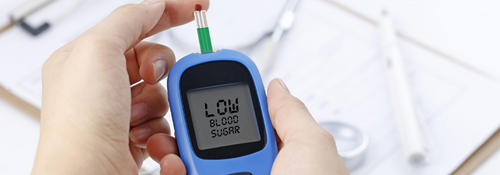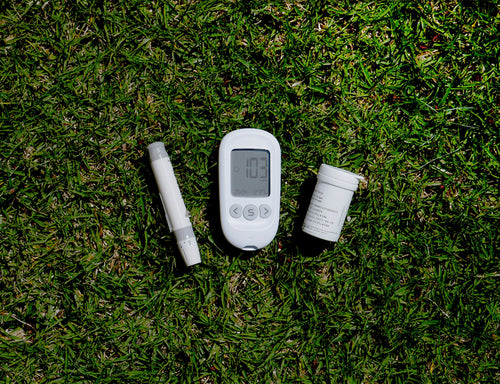Symptoms of low blood glucose
Hypoglycaemia is a medical condition which occurs when blood sugar levels get dangerously low. The symptoms of low blood glucose may present themselves in several ways.
Most people begin experiencing hypoglycaemia when their blood sugar level drops below 4 mmol/L, however, this figure may vary from person to person depending on several factors.
Symptoms of low blood glucose typically progress from confusion and drowsiness to changes in behaviour and in very serious cases coma, seizures, and even death.
Why is glucose important?
Glucose is a type of sugar you get from foods you eat, and your body uses it for energy. Think of the human body as an engine and glucose as the fuel it needs to run. Blood glucose or blood sugar is the amount of glucose travelling through your bloodstream to your cells at any given time.
The presence of glucose in the blood triggers the pancreas to release insulin which helps the cells to absorb it from the bloodstream. People with diabetes are unable to manage their body’s insulin and may need to take insulin shots to regulate their blood sugar levels.
Without glucose, the body doesn’t have enough energy to function properly. A healthy blood glucose level typically ranges between 3.9 – 7.1 mmol/L. This figure changes at different times of the day depending on our eating habits and lifestyle.
You may experience the potentially harmful symptoms of low blood sugar if this level goes below 4.0 mmol/L. When this happens, you should take immediate action to bring it back up to prevent symptoms from worsening.
People with diabetes should check their blood sugar level with a glucometer if they begin feeling symptoms of hypoglycaemia. It is important to begin treatment as soon as possible if you or someone around you experiences any of the signs below.
Common symptoms of Hypoglycaemia
The symptoms of hypoglycaemia range from mild to moderate depending on the amount of glucose in the blood. Most people may not feel any symptoms at 4.0 mmol/L, but will feel progressively worse as blood sugar levels fall.
Familiarise yourself with the common symptoms so you can take action quickly.
People with mild to moderate hypoglycaemia may experience adrenergic (or sympathetic) symptoms which affect their nervous system. These include:
- Dizziness or light-headedness
- Blurred vision
- Intense hunger
- Feeling weak, sleepy, or tired
- Severe headaches and sweating
- Sudden confusion or disorientation
- Pale, cold, or clammy skin
- Trouble concentrating
- Rapid or irregular heart rate
In most cases, these symptoms will be easily recognisable and immediate treatment will provide quick relief.
People with diabetes may experience this degree of hypoglycaemia if they are on a form of insulin medication, although the symptoms may not be so clear. Hypoglycaemic unawareness can be especially dangerous as blood sugar levels can be critically low before a self-diagnosis is made.
Consuming foods rich in carbohydrates can help provide immediate relief by giving your body some much-needed fuel. However, this should be accompanied by a blood test to ensure the right blood sugar levels have been achieved.
Symptoms of severe Hypoglycaemia
Symptoms of hypoglycaemia usually worsen the lower the blood glucose gets. Patients may experience severe hypoglycaemia when this level goes below 3.0 mmol/L. This is a potentially life-threatening condition. People with severe hypoglycaemia may experience the following symptoms:
- Body tremors or trembling
- Numbness of the tongue, lips, or cheek
- Mood swings or changes in personality
- Nausea, vomiting, abdominal discomfort
- Seizures or convulsions
- Loss of consciousness or coma
In some rare cases, severe hypoglycaemia may prevent people from responding to treatment by eating something to raise their blood sugar. At this point, the patient may begin experiencing neuroglycopenic symptoms as the brain fails to get enough glucose.
When this happens, glucose shots may be administered to raise their glucose levels quickly. If you start to experience any of the above symptoms you must seek medical attention or dial 111 to reach the NHS helpline.
Watch out for early signs such as confusion or drowsiness to improve your treatment response time. If you suffer from hypoglycaemia often, you should always keep glucose tablets on your person in order to boost your sugar levels when needed.
Treating low blood glucose
You can easily treat mild to moderate hypoglycaemia by following the 15-15-minute rule. The rule states that:
Consume:
15 grams of carbohydrates such as a slice of bread, 100g yoghurt, a small banana, an apple, a glass of fruit juice or 4 glucose tablets
Wait:
15 minutes to allow the body to absorb the glucose from these foods before testing your blood glucose again to see if it rises above 4.0 mmol/L
Repeat:
If necessary or until your blood sugar level gets to 4.0 mmol/L or above
Eat:
A balanced meal as soon as possible to prevent a relapse.


